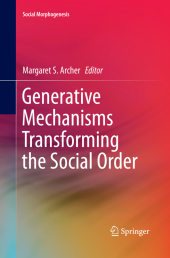 Neuerscheinungen 2016Stand: 2020-02-01 |
Schnellsuche
ISBN/Stichwort/Autor
|
Herderstraße 10
10625 Berlin
Tel.: 030 315 714 16
Fax 030 315 714 14
info@buchspektrum.de |

Margaret S. Archer
Generative Mechanisms Transforming the Social Order
Herausgegeben von Archer, Margaret S.
Softcover reprint of the original 1st ed. 2015. 2016. viii, 248 S. 10 SW-Abb., 4 Farbabb. 235 mm
Verlag/Jahr: SPRINGER, BERLIN; SPRINGER INTERNATIONAL PUBLISHING 2016
ISBN: 3-319-36246-1 (3319362461)
Neue ISBN: 978-3-319-36246-5 (9783319362465)
Preis und Lieferzeit: Bitte klicken
This volume examines how generative mechanisms emerge in the social order and their consequences. It does so in the light of finding answers to the general question posed in this book series: Will Late Modernity be replaced by a social formation that could be called Morphogenic Society? This volume clarifies what a ´generative mechanism´ is, to achieve a better understanding of their social origins, and to delineate in what way such mechanisms exert effects within a current social formation, either stabilizing it or leading to changes potentially replacing it . The book explores questions about conjuncture, convergence and countervailing effects of morphogenetic mechanisms in order to assess their impact. Simultaneously, it looks at how products of positive feedback intertwine with the results of (morphostatic) negative feedback. This process also requires clarification, especially about the conditions under which morphostasis prevails over morphogenesis and vice versa. It raises the issue as to whether their co-existence can be other than short-lived. The volume addresses whether or not there also is a process of ´morpho-necrosis´, i.e. the ultimate demise of certain morphostatic mechanisms, such that they cannot ´recover´. The book concludes that not only are generative mechanisms required to explain associations between variables involved in the replacement of Late Modernity by Morphogenic Society, but they are also robust enough to account for cases and times when such variables show no significant correlations.
Foreword.- Chapter 1. Introduction: Other Conceptions of Generative Mechanisms and Ours; Margaret S. Archer.- Part I. Conceptualising Mechanisms.- Chapter 2. Causal Mechanisms: Lessons from the Life Sciences; Philip Gorski.- Chapter 3. Mechanisms and Models; Some Examples from International Relations; Colin Wright.- Chapter 4. Social Mechanisms and Their Feedbacks; Pierpaolo Donati.- Part II. Venturing Morphogenetic Mechanisms.- Chapter 5. ´´Mechanisms´´ of the Build-Up of Information Society; Wolfgang Hofkirchner.- Chapter 6. Body Captors and Network Profiles: A Neo-Structural Note on Digitalized Social Control and Morphogenesis; Emmanuel Lazega.- Chapter 7. How Agency is Transformed in the Course of Social Transformation: Don´t Forget the Double Morphogenesis; Margaret S. Archer.- Chapter 8. Turbulence and Relational Conjunctures: The Emergence of Morphogenic Environments; Andrea Maccarini.- Part III. Mechanisms and Morphostasis: Power of Life and Death.- Chapter 9. Why Don´t Things Change? The Matter of Morphostasis; Douglas V. Porpora.- Chapter 10. The Modern Corporation: The Site of a Mechanism (of Global Social Change) that is Out-of-Control; Tony Lawson.- Chapter 11. Death Contested: Morphonecrosis and Conflicts of Interpretation; Ismael Al-Amoudi and John Latsis.


